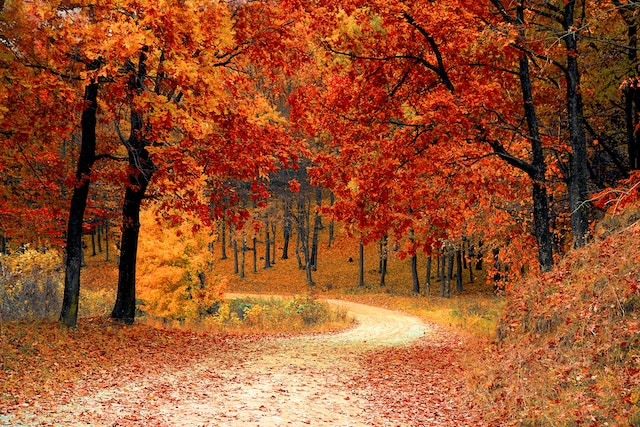
Why do the leaves on a tree change color in the autumn (fall)? The leaves on trees change color in the autumn because the tree breaks down its own chlorophyll.
Not all trees lose their leaves. Evergreen trees keep their leaves throughout the year. Trees that lose their leaves in the winter are called deciduous trees. They lose their leaves for three reasons.
Firstly, having no leaves means the tree will be better able to survive a winter. Leaves have a very large surface area, which means the tree is more at risk from wind and snow damage with them still on the tree. A cubic meter of snow weighs about 50 kg. An average oak leaf has a surface area of 8 cm by 15 cm. If we assume that 5 cm of snow could settle on the leaf, that works out to about 30g of snow per leaf. An oak tree has about 500,000 leaves, which would work out to about 15 tons of snow. I know there are a lot of variables I haven’t considered here, but you get the idea.
Secondly, losing its leaves allows a tree to conserve resources and energy. There is very little water available in the water and what is around is often frozen. If the tree kept its leaves, it would lose water because of their large surface area and it wouldn’t be able to replenish the lost water. Also, photosynthesis cannot happen at very cold temperatures because the molecules and the enzymes slow down too much, so the tree would be making no energy. There would be a net loss throughout the winter. On top of that, the leaves would freeze because they are thin, and then their cells would rupture.
And, lastly, the tree can lose all of the leaves that are old and insect-bitten and start afresh with new ones in the spring.
So, why do the leaves on a tree change color in the autumn? Trees can sense when the days are getting shorter. They have chemical light receptors that detect red and blue light. This is why plants are able to angle themselves towards the sunlight to get as much light as they can. When they sense that there is less light, and the days are getting shorter, they start the process of losing their leaves.
The first thing they do is to break down and reabsorb all of the chlorophyll from the leaves. This is the green pigment in the leaves that they use for photosynthesis. It takes a lot of energy to make chlorophyll and trees constantly renew it throughout the year. When the days get shorter, they stop renewing it and simply break it down. The tree stores all of this chlorophyll in its roots, as food, ready for the next year.
When the green chlorophyll is gone, another pigment called carotenoids become visible. Carotenoids are yellow, orange and brown pigments. They are also used for photosynthesis, by passing light energy to the chlorophyll. Their color allows the trees to absorb a broader range of lightwaves in order to photosynthesize. When the green chlorophyll is gone, the carotenoids are left, giving the trees the golds, oranges, and browns of autumn. Some trees also produce anthocyanins which are red and purple. These lower a leaf’s freezing point and let them stay on the tree for longer.
After the chlorophyll has been reabsorbed, the layer of cells where the leaf is connected to the branch, called the abscission layer, harden and seal off the leaf, stopping its water supply. This layer then dries and becomes brittle. Then the tree relies on the wind to shake all of these brittle leaves off. The abscission layer seals up the branch so there is no hole left.
When trees photosynthesize, they make energy in the form of carbohydrates. This energy is converted to starch and is stored in the tree. The starch is then converted to sugar and dissolved into sap. The tree stores all of this sap in its trunk and roots. The high level of sugar in the sap lowers its freezing point, protecting the tree from freezing in the winter. Then, when the weather warms and the day length increases, the tree pumps the sap back up and uses it to grow new leaves in the spring. This is the point where maple syrup farmers tap the tree.
So, we can see so many beautiful colors in an autumn forest because the trees have absorbed the chlorophyll from their leaves in preparation for winter. And this is what I learned today.
Source
https://www.discoverwildlife.com/plant-facts/trees/does-tree-sap-freeze/
https://en.wikipedia.org/wiki/Carotenoid
https://www.newscientist.com/article/mg21528791-800-plant-senses-sight/
https://forestryandland.gov.scot/blog/trees-in-autumn
https://www.open.edu/openlearn/science-maths-technology/scales-space-and-time/content-section-2.7
https://spacemath.gsfc.nasa.gov/earth/89Mod11Prob2.pdf
https://askabiologist.asu.edu/questions/why-do-leaves-change-color
